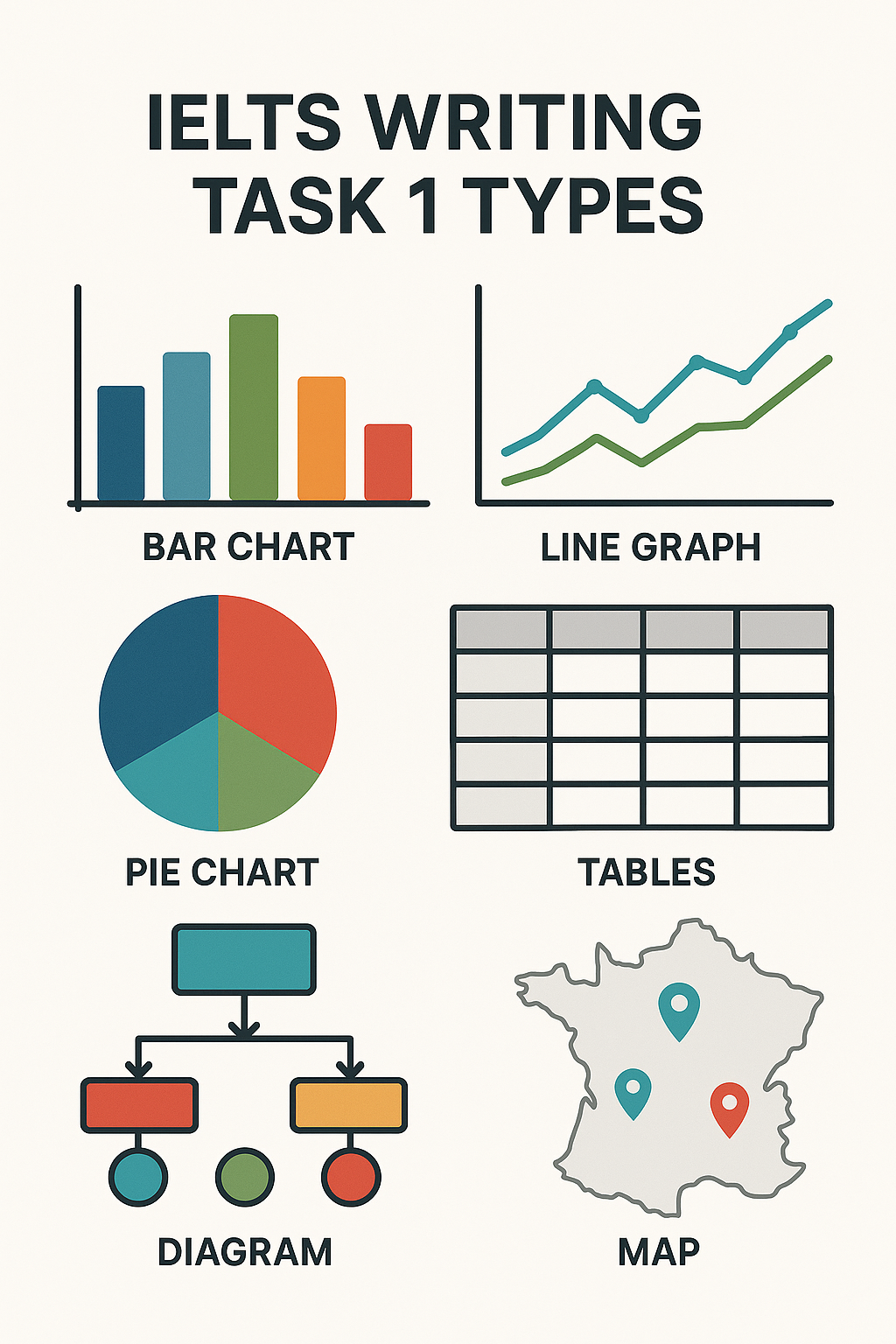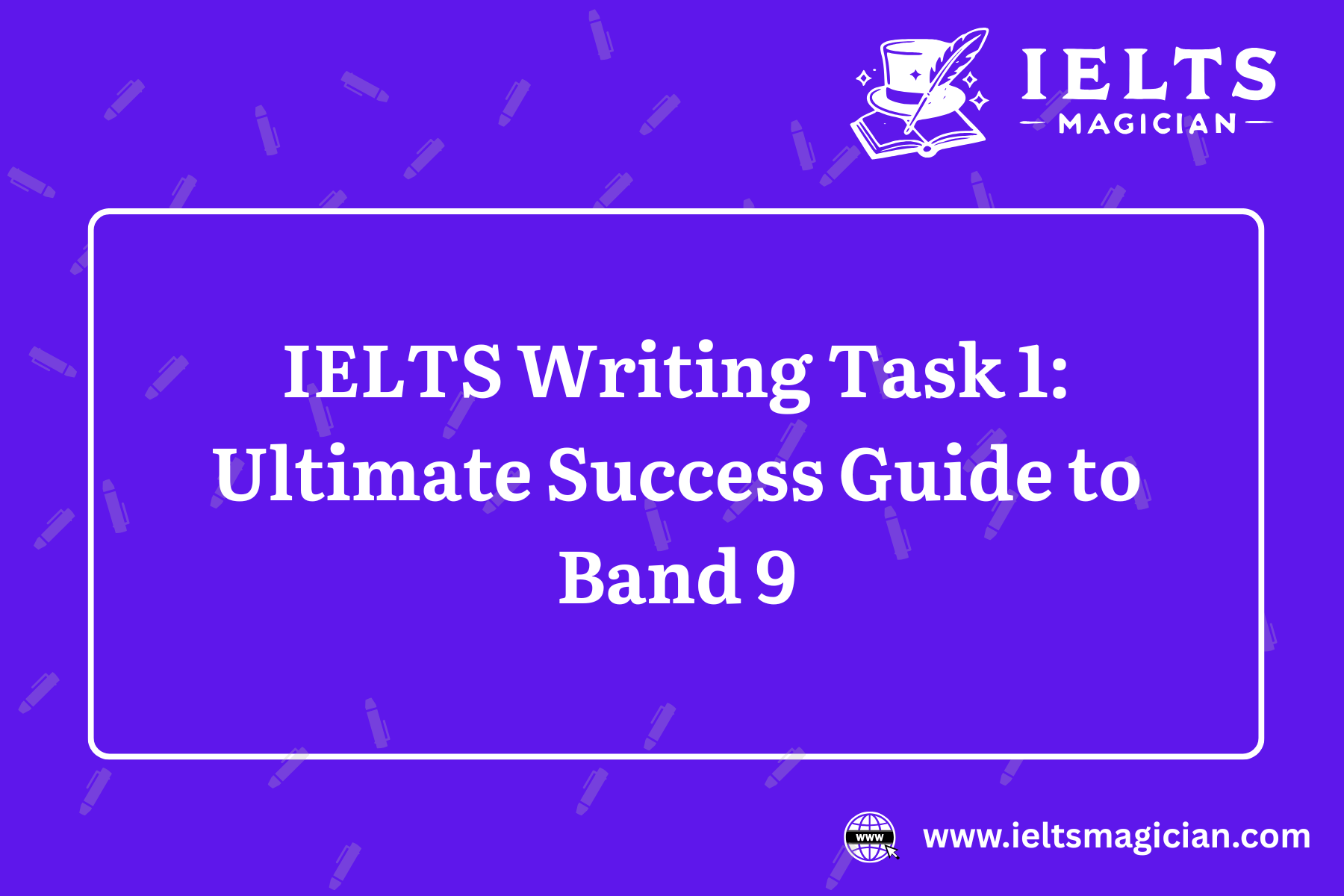IELTS Writing Task 1 assesses a candidate’s ability to describe and summarize visual information clearly and accurately.
You need to interpret a graph, chart, table, diagram, map, or process and present the main features in a structured, academic report.
This task emphasizes formal tone, coherence, and appropriate vocabulary, all under a 20-minute time limit.
What is IELTS Writing Task 1?
IELTS Writing Task 1 requires the candidate to respond to visual data by describing key trends, comparing figures, and summarizing main patterns.
The response must be organized, objective, and within a minimum of 150 words.
- Word count: minimum 150
- Time limit: 20 minutes
- Task type: visual data description
- Skills tested: accuracy, vocabulary, structure, grammar
The task evaluates how well the candidate describes data, outlines features, and presents comparisons using academic language.
What Is the Main Goal of IELTS Writing Task 1?
Task 1 requires candidates to describe, compare, and summarize visual information using academic language.
The report should not include opinions or assumptions. Candidates must:
- Identify key trends or features
- Compare data logically
- Organize information clearly
Use a formal tone and precise vocabulary
How is the IELTS Writing Task 1 Scored?
Examiners use four band descriptors, each carrying equal weight:
| Criterion | Focus Area |
| Task achievement | How well the response covers all parts of the prompt |
| Coherence and cohesion | Logical flow, paragraphing, and linking devices |
| Lexical resource | Range and accuracy of vocabulary |
| Grammatical range | Sentence variation and grammatical correctness |
To achieve a high score, candidates must present clear comparisons, use accurate grammar, and maintain a formal tone.
How Can I Improve My Score in Writing Task 1?
To improve your IELTS Writing Task 1 score, consider the following tips:
- Organize your response logically: Begin with an introduction, followed by an overview and details.
- Describe data accurately: Be precise when presenting numerical information, highlighting key trends.
- Use varied vocabulary: Avoid repetition by using synonyms and paraphrasing the question effectively.
- Focus on clarity and conciseness: Your response should be easy to follow, with no unnecessary information.
- Check grammar and spelling: Errors in grammar and spelling can negatively affect your score.
What Visuals Can Appear in IELTS Writing Task 1?
The writing task presents visual data that the candidate must describe, analyse, or compare. Candidates are asked to interpret one or more of the following visual types:
- Bar charts
- Line graphs
- Pie charts
- Tables
- Diagrams
- Maps
- Processes

| Visual Type | Description | Example Verbs Used |
| Bar Chart | Compares discrete values across categories | compare, describe, group |
| Line Graph | Shows trends over time | highlight, contrast, observe |
| Pie Chart | Displays proportionate data | summarize, report, analyze |
| Table | Presents categorized numerical data | interpret, outline, evaluate |
| Process Diagram | Illustrates a step-by-step process | explain, describe, identify |
| Map | Shows spatial changes or developments | compare, highlight, structure |
Examples:
- A line graph illustrates comparisons in yearly smartphone sales.
- A map shows urban development before and after 2000.
- A diagram explains the steps in recycling plastic bottles.
Each visual type requires different descriptive strategies but always demands accurate reporting of trends and figures.
What Is the Best Structure for IELTS Writing Task 1?
Organized structure is essential for clarity and coherence. A four-paragraph format is recommended:
- Introduction
Paraphrase the question and state what the visual represents. - Overview
Identify and summarize the main trend, difference, or process flow without specific data. - Body Paragraph 1
Describe key details, patterns, and data for the first half of the visual. - Body Paragraph 2
Compare remaining data, highlight contrasts, and interpret other relevant features.
This structure ensures the response is logical and meets examiner expectations.
What Are the IELTS Writing Task 1 Band Descriptors?
The official IELTS scoring for Task 1 uses four metrics:
| Band Criteria | Definition |
| Task Achievement | Fully covers the visual, accurate comparisons, proper summary |
| Coherence and Cohesion | Logical flow, clear paragraphing, proper use of cohesive devices |
| Lexical Resource | Range of vocabulary, accurate word choice for comparisons and visuals |
| Grammatical Range | Variety of sentence structures, control of tense and agreement |
Each is worth 25% of the total score. A Band 9 response must show accurate reporting, advanced vocabulary, and consistent grammar.
What Is the Word Count Requirement in IELTS Writing Task 1?
- Minimum: 150 words
- Recommended: 160–180 words
- Penalty: Scores are reduced for under length answers
Time management tips:
- Spend 2–3 minutes analysing the task
- Write for 14–15 minutes
- Use the last 2–3 minutes to review grammar and vocabulary
Writing more than 200 words may lead to rushed or off-topic sentences, so balance quality and quantity.
How to Improve Coherence in IELTS Task 1?
Coherence refers to logical connections between ideas. To improve it:
- Use linking words: meanwhile, whereas, similarly, in contrast
- Group similar information together
- Maintain one idea per sentence or clause
- Use paragraphing effectively
Example:
Unclear: The table shows car usage. People also use buses.
Improved: The table shows that car usage increased, while bus usage declined slightly in the same period.
What Vocabulary Should Be Used in Task 1?
Task 1 writing must be formal, objective, and descriptive. Use accurate verbs and adjectives to present data clearly.
Verbs to describe data:
- describe
- analyze
- compare
- summarize
- identify
- present
- illustrate
- explain
- highlight
- support
- report
- interpret
- outline
- evaluate
- respond
Comparative Vocabulary
- Slightly higher than
- Increased sharply
- Declined gradually
- Remained stable
- Was the most significant
- Accounted for the majority
Grouping and Trend Vocabulary
- Categorized into
- Shared a similar pattern
- Followed a steady increase
- Reached a peak
- Declined to the lowest point
Adjectives for tone and structure:
- academic
- coherent
- clear
- accurate
- formal
- concise
- logical
- structured
- detailed
- objective
- neutral
- visual
- descriptive
- appropriate
- organized
Sample usage:
- The graph illustrates a steady rise in tourism between 2000 and 2020.
- The table compares literacy rates across four countries.
- The diagram outlines the process of electricity generation from wind turbines.
What Does a Band 9 IELTS Task 1 Response Look Like?
A Band 9 report is clear, objective, and shows advanced language use.
Features of Band 9:
- Fully addresses all parts of the task
- Overview summarizes key features accurately
- Paragraphs are well-organized and logically sequenced
- Vocabulary is precise and varied
- Grammar is error-free with complex structures
Example:
“The line graph shows a consistent rise in smartphone usage between 2010 and 2020. While youth adoption peaked in 2018, adult usage rose steadily. Overall, digital device usage experienced upward trends across all age groups.”
How Can You Improve Your Task 1 Score?
Use these tips to strengthen each scoring area:
- Plan your response in 3–4 minutes
- Identify main trends before writing
- Use accurate data from the visual
- Avoid personal opinions or speculation
- Paraphrase effectively
- Vary your sentence structures
- Proofread with 2 minutes left
What Are Common Challenges for Candidates?
Common challenges that candidates face in IELTS is as followed:
- Omitting an overview
- Misreporting data
- Using informal language
- Lack of clear comparisons
- Repetition of words and phrases
- Not reaching the word count
Examiner expectations:
Examiners want responses that are:
- coherent and logically organized
- factually correct and visually accurate
- free from opinion or bias
- supported by data from the visual
- clearly structured with appropriate transitions
What Are Common Mistakes in IELTS Writing Task 1?
Avoid the following to maintain clarity and task achievement:
- Describing every number in detail
- Using informal tone or contractions
- Misinterpreting visual data
- Mixing tenses (past vs present)
- Ignoring the overview
- Repeating the same vocabulary
Key Tips for Describing Data in Writing Task 1
Effective data description requires both clarity and precision. Use the following strategies to enhance your description:
- Compare and contrast: Highlight significant differences or trends in the data.
- Summarize key features: Focus on the most relevant information, avoiding excessive detail.
- Use accurate data: Ensure that the data is presented correctly, and always report figures with precision.
- Maintain objectivity: Refrain from making subjective judgments; just describe the data as it is.
Summary of Key Attributes for High Scoring Task 1
| Attribute | Description |
| clarity | express ideas without ambiguity |
| accuracy | describe data with correct figures and terms |
| structure | organize the response into clear paragraphs |
| formality | use academic and objective tone |
| word count | meet the 150-word minimum |
| coherence | link ideas and information logically |
| grammar | vary sentence structures with correct usage |
| vocabulary | use topic-relevant, precise words |
| relevance | avoid off-topic or opinion-based content |
| tone | maintain neutral, descriptive voice |
Conclusion
IELTS Writing Task 1 demands clear interpretation of visual data, accurate comparisons, and organized presentation. You should identify trends, describe processes, and outline key differences using academic vocabulary and a formal tone. The structure must be logical, and every sentence should support the visual description. Practicing with different types of visuals and mastering the appropriate verbs, adjectives, and comparisons can significantly raise your writing band score. Aim for clarity, accuracy, and coherence in every response.

